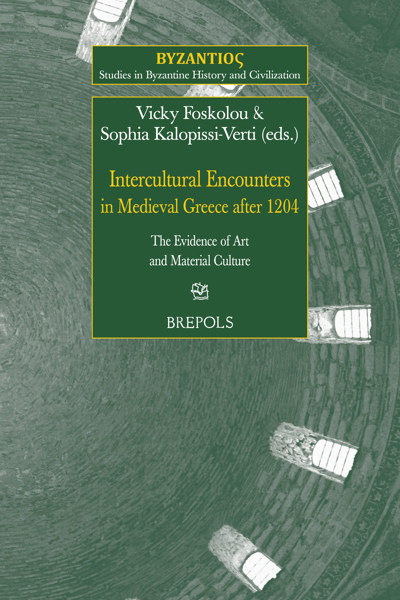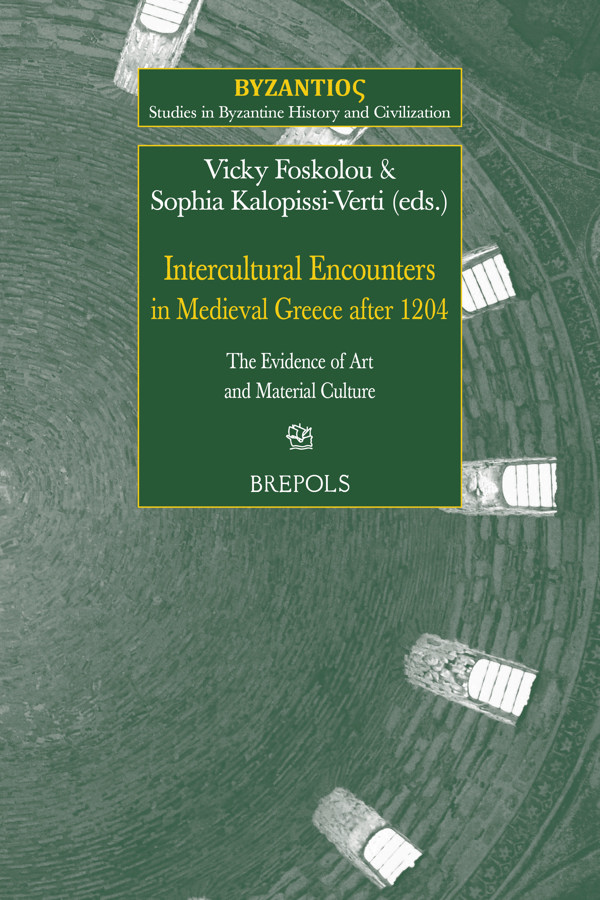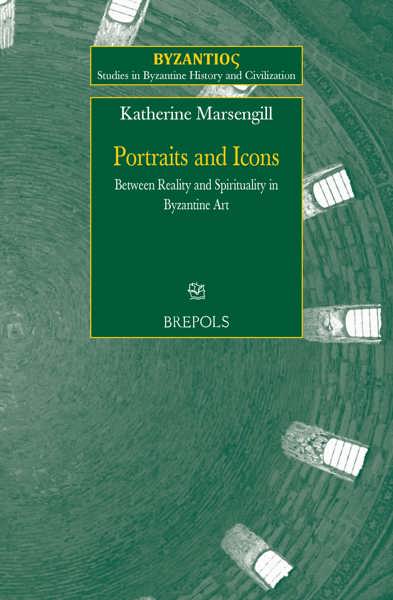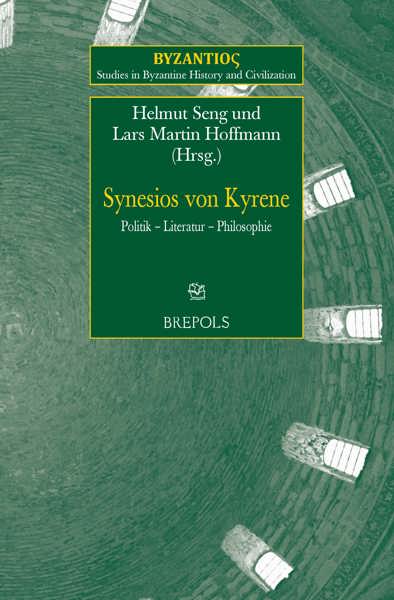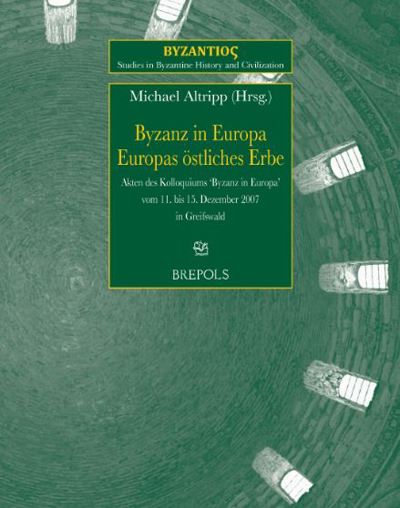
Intercultural Encounters in Medieval Greece after 1204
The Evidence of Art and Material Culture
Sophia Kalopissi-Verti, Vicky Foskolou (eds)
- Pages: 572 p.
- Size:156 x 234 mm
- Illustrations:220 b/w, 35 col.
- Language(s):English
- Publication Year:2022
- € 95,00 EXCL. VAT RETAIL PRICE
- ISBN: 978-2-503-59850-5
- Paperback
- Available
- € 95,00 EXCL. VAT RETAIL PRICE
- ISBN: 978-2-503-59851-2
- E-book
- Available
This volume is a contribution to the ongoing scholarly dialogue on a crucial topic, viz. the relations between East and West and their reflection in art and culture in late medieval Greece.
- Cultural & intellectual history (c. 500-1500)
- Eastern & Orthodox Christianity & Churches (from c. 312)
- Western Church : history & papacy
- Cultural exchanges, transfers and influences
- Medieval Archaeology
- Objects and materials (antiquities & material culture)
- Byzantine art history
- Byzantine architecture
- Political & institutional history (c. 500-1500)
- Religious history (c. 500-1500)
- Balkans & Western Asia (Near East) (c. 500-1500)
"This is a specialist work, so it will be of most interest to academics and research students, but some chapters will also be of considerable use for teaching purposes, not least because they open up specialist areas of research which are not always accessible in English. This is a specialist work, so it will be of most interest to academics and research students, but some chapters will also be of considerable use for teaching purposes, not least because they open up specialist areas of research which are not always accessible in English.(…) It is a valuable contribution to the historiography on this area." This is a specialist work, so it will be of most interest to academics and research students, but some chapters will also be of considerable use for teaching purposes, not least because they open up specialist areas of research which are not always accessible in English. (Mike Carr, in Journal of Greek Archaeology, 9, 2024, p. 503-505)
"The volume refreshingly imposes no chronological markers on medieval Greece, beyond the starting date of 1204 set out in the title. The fall of Constantinople barely features in a series of papers that cover the period from the thirteenth to the seventeenth centuries. Reading the volume as a whole, we are asked to focus instead on continuities and the longue durée interaction between the Latin West and the Greek East." (Antony Eastmond, in The English Historical Review, 2024, https://doi.org/10.1093/ehr/ceae063)
"The fourteen richly documented studies, with the profiles and credentials of its sixteen contributors, all Greek, provide a highly commendable picture of the standards of the Greek academia and the National Ephorates, the Culture Supervising Agencies of Greece, which these scholars serve and represent. What is beyond doubt is that there is very much of history (and not only medieval), geography, culture, theology, politics, ideology, social and ecclesiastical life etc. to be learned from this volume in addition to art, architecture, iconography, history of art, trends, schools and methodologies. The 245 Figures and the 35 Plates enriching the volume with visual evidence and color, make it a valuable addition to an academic and private library." (Daniel J. Sahas, in The Byzantine Review, 04.2022.018, doi: 10.17879/byzrev-2022-4393)
«Ένας τόμος επιμελημένος από δύο εξέχουσες και διακεκριμένες ερευνήτριες της βυζαντινής τέχνης και αρχαιολογίας δεν θα μπορούσε παρά να είναι μία ευτυχής εκδοτική συγκυρία. (...) Συμπερασματικά, με τον εν λόγω τόμο επιχειρούνται επίκαιρες μεθοδολογικές και ερευνητικές υπερβάσεις, οι οποίες προωθούν ουσιαστική επανεξέταση και δυναμική επέκταση των ορίων και πεδίων της μελέτης του μεσαιωνικού υλικού πολιτισμού στον ελλαδικό χώρο.» (Sophia Germanidou, in Byzantina Symmeikta 33, 2023, doi: 10.12681/byzsym.32429)
« Il faut surtout surtout souligner la richesse de la documentation fournie, la minutie de la présentation des oeuvres tour à tour considérées, et la solidité des argumentations déployées pour leur interprétation. » (Jean-Pierre Caillet, dans Deltion of the Christian Archaeological Society 43. 2022, p. 435-438)
« (...) par la richesse de ses illustrations (liste p. 23–42), parmi lesquelles 35 planches en couleurs en fin de vol., la variété de ses thématiques et ses hypothèses audacieuses, cet ouvrage contribue largement aux discussions sur les interactions entre Grecs et Latins du xiiie au xve siècle.» (Marie Guérin, dans Le Moyen Age, CXXX, 2024, p. 651)
Sophia Kalopissi-Verti is Professor Emerita of Byzantine Archaeology at the National and Kapodistrian University of Athens. She is co-director of excavations of early Byzantine sites on the island of Kos (Dodecanese) and at Sinai, and the author of a book on Dedicatory Inscriptions and Donor Portraits in Thirteenth-Century Churches of Greece.
Vicky Foskolou is Assistant Professor of Byzantine Archaeology at the University of Crete. Her research focuses on Byzantine monumental painting and iconography, cross-cultural exchanges between Byzantium and the West, and aspects of private devotion in the Byzantine world.
Based on the evidence of artistic production and material culture this collective volume aims at exploring cross-cultural relations and interaction between Greeks and Latins in late medieval Greece in the aftermath of the Fourth Crusade. Fourteen essays discuss mostly new and unpublished archaeological and artistic material, including architecture, sculpture, wall-paintings and icons, pottery and other small finds, but also the evidence of music and poetry. Through the surviving material of these artistic activities this volume explores the way Byzantines and Latins lived side by side on the Greek mainland and the Aegean islands from the thirteenth to the fifteenth centuries and traces the mechanisms that led to the emergence of the new, composite world of the Latin East. Issues of identity, patronage, papal policy, the missionary activities of the Latin religious orders and the reactions and responses of the Byzantines are also re-considered, offering fresh insights into and a better understanding of the various manifestations of the interrelationship between the two ethnicities, confessions and cultures.
Introduction
List of Abbreviations
List of Illustrations
PART I: TRACING THE LATIN IDENTITIES AND THE ROLE OF THE MENDICANTS
Michalis Olympios, Architecture, Use of Space, and Ornament in the Mendicant Churches of Latin Greece: An Overview
Vicky Foskolou, Reflections of Mendicant Spirituality in the Monumental Painting of Crete in the Late Medieval Period (13th–15th centuries)
Nickiphoros I. Tsougarakis, Art, Identity, and the Franciscans in Crete
Ioanna Bitha and Anna-Maria Kasdagli, Saint George ‘of the English’: Byzantine and Western Encounters in a Chapel of the Fortifications of Rhodes
Dimitris Kountouras, Western Music and Poetry at the Kingdom of Thessalonica: Music and Historiography of the Fourth Crusade
PART II: SOCIAL TRANSFORMATIONS AND MUTUAL APPROACHES: THE EVIDENCE OF ARCHAEOLOGY AND MATERIAL CULTURE
Olga Gratziou, Imported Projects, Local Skills, and the Emergence of a ‘Cretan Gothic’
Anastasia Vassiliou, Glazed Pottery in Late Medieval Morea (13th–15th Centuries): Cross-Cultural Tableware with Multiple Connotations
Maria Michailidou, Pottery Finds in the Medieval Town of Rhodes (1204−1522): Insights on a Multicultural, Cosmopolitan Society
Eleni Barmparitsa, Dress Accessories and Sartorial Trends in the Principality of Achaia (1205–1428): Evidence from the Frankish Castles of Chlemoutsi and Glarentza
PART III: CULTURAL INTERACTIONS AND BYZANTINE RESPONSES: THE EVIDENCE OF ARCHITECTURE, MURALS, AND ICON PAINTING
Michalis Kappas, Cultural Interactions between East and West: The Testimony of Three Orthodox Monasteries in Thirteenth-Century Frankish Messenia
Aspasia Louvi-Kizi, Politics of Equilibrium: Gothic Architectural Features at Mystras (1361–71), Cypriot Models, and the Role of Isabelle de Lusignan
Nikolaos Mastrochristos and Angeliki Katsioti, Reconstructing the Artistic Landscape of Rhodes in the Fifteenth Century: The Evidence of Painting from Lindos
Konstantia Kefala, Permeable Boundaries of Artistic Identity: The Origin of a Fifteenth-Century Annunciation
Sophia Kalopissi-Verti, Preaching, the Role of the Apostles, and the Evidence of Iconography in East and West: Byzantine Responses to the ‘Challenges’ from the Latin Church after 1204
Notes on Contributors
Index
